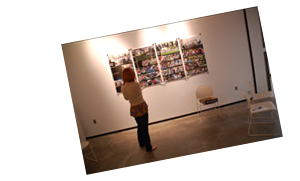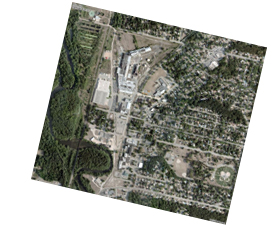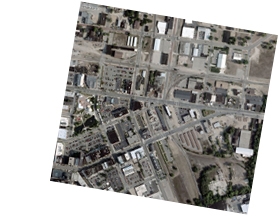Teaching Time and Place Storytelling
As an Adjunct Assistant Professor of Art at Western Michigan University, I teach several courses in the graphic design program. I’ve also developed and taught an experimental course related to storytelling, Time&place-based Media (scroll down). I tell graphic design students that they could think of themselves as storytellers. I encourage them to explore areas related to design and storytelling. The following Independent Study is an example.
Independent Study
During the 2009 Spring Semester a graphic design student in her junior year enrolled for an independent study with me in the Gwen Frostic School of Art at Western Michigan University. Her area of study was related to time and place storytelling. In the context of the Time&place-based Media course that I developed and taught the year before (see below), her work could be considered a time and place data interface that visualizes and tells stories about different places at different times.
She proposed an independent study to create an interactive visual memoir, documenting three summers in New York City, Saint Louis, and Prague. She wanted her memoir to be a resource and inspiration for students and community in communicating the value of work, study, and travel, especially during college summers.
Throughout the semester she explored storytelling possibilities, while pouring over her paper and online journals, sketches, photos, videos, and artifacts. The compulsiveness of her journaling and sketching suggested the theme for her story: “I Can’t Stop”. She decided to install her visual memoir in the largest of the critique spaces in the Frostic School of Art because she was visualizing experiences in three places that were distant from one another, and wanted to work with the physicality of the large space.
She decided to represent time along a horizontal continuum, connecting the three places with her journaling, as in reality she had done. Copies of her paper journals and printouts of her online journals floated throughout the space, on and off the walls. A sense of place was created along her time continuum with interstitial artifacts. Similarly, a sense of time was created in her three places with journals. Thus, her visual memoir could be read by time and/or place.
She decided to represent place with artifacts, drawings from journals, photographs, and video projections, affording viewers an immersive sense of place. Viewers were prompted to interact with her installation by moving about in time (three summers) and place (three cities). In addition to intersections of time and place, there were meaningful and symbolic juxtapositions of media and events.
She invited visitors to the opening of her installation (during finals week) with posters and video spots throughout the school. She attracted an audience, and engaged visitors with her stories of time and place. In the context of my own professional exhibition work and openings I’ve attended, she very successfully engaged her audience (of all ages) in “reading” and responding to her stories.
In her own words:
If I could have taken you with me, my first summer of college, to live in Brooklyn, I would have. If you could’ve moved to Saint Louis my second summer, or Prague my third, I would’ve liked the company.
Without you there, I stumbled into, searched for, fell in love with, and suffered from experiences I will never find the words to accurately and honestly describe. Instead, I’m ready to show you. This is a compilation of three summers spent outside Michigan. Working too many hours, disappearing into cityscapes, attaching myself to and throwing my faith behind perfect strangers. Blind ambition has propelled me to take these risks, one after the other: I can’t stop.
This is a collection of moments, memories, and confessions. It is intended to motivate, teach and tell. Entirely based off journals I kept while living out of state (or later, out of country), this exhibit is something I’ve loosely labeled a visual memoir. A fragmented narrative of the lessons I have learned outside of school, and a reminder of the value of summer.
Time&place-based Media
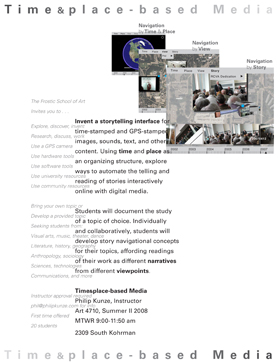 In early 2008 I developed an experimental course in storytelling by time and place. I called this special topics course Time&place-based Media, and offered it at Western Michigan University in the Gwen Frostic School of Art during the second summer semester in 2008. I described the course as an advanced seminar course that “explores possibilities for automating the telling and reading of stories by time and place, from different points of view.” Students would document the study of a topic, making digital recordings. All files would be timestamped and placestamped. Arrays of data in several media, structured by time and place, would be composed as different narratives.
In early 2008 I developed an experimental course in storytelling by time and place. I called this special topics course Time&place-based Media, and offered it at Western Michigan University in the Gwen Frostic School of Art during the second summer semester in 2008. I described the course as an advanced seminar course that “explores possibilities for automating the telling and reading of stories by time and place, from different points of view.” Students would document the study of a topic, making digital recordings. All files would be timestamped and placestamped. Arrays of data in several media, structured by time and place, would be composed as different narratives.
It was an interdisciplinary course with no prerequisites, open to all university students. I promoted the course across campus in as many media as possible, networking with faculty, and describing the course in as many classrooms as I could. In creating and teaching the course I drew upon many university and community resources.
I challenged students to develop data navigation concepts, or ways of interacting with data (user interfaces), for telling and reading individual and community stories by time and place, seeking new ways to translate data into information and knowledge.
 At the beginning of the semester I asked: How can large data sets arrayed by time and place tell meaningful stories about events experienced from different points of view? Together, we explored answers to this question through research, discussion, and our work. We had discussions in class, and students worked mostly in the field.
At the beginning of the semester I asked: How can large data sets arrayed by time and place tell meaningful stories about events experienced from different points of view? Together, we explored answers to this question through research, discussion, and our work. We had discussions in class, and students worked mostly in the field.
During the first few weeks of the semester students developed topic ideas for storytelling. Resource people were invited to present ideas and tools for storytelling in a mini colloquium series. Students participated in a “journal club” as a means of studying, sharing, and synthesizing information.
Time was an important consideration in selecting topics, and students were allowed to study any period of time. Place was limited to the Kalamazoo area. Students were encouraged to consider different points of view of a place over time. Student topics included explorations of the aftermath of deindustrialization, changing urban landscapes, performances, and responses to performances.
Students documented explorations of topics digitally. As image and sound files were aggregated, students discovered ways to read data as stories by time, place, and different points of view, employing various hardware, software, and Webware tools.
 At the end of the semester students installed their work in two of the critique spaces in the School of Art. We celebrated the journey, inviting those in the community who participated, our academic community, and interested others, in hopes of suggesting future projects, sparking synergies, and identifying potential larger applications to develop. Students invited family and friends. Students talked informally with guests about their work, and talked with one another. The course fulfilled my hope that students would learn from their own work and from each another.
At the end of the semester students installed their work in two of the critique spaces in the School of Art. We celebrated the journey, inviting those in the community who participated, our academic community, and interested others, in hopes of suggesting future projects, sparking synergies, and identifying potential larger applications to develop. Students invited family and friends. Students talked informally with guests about their work, and talked with one another. The course fulfilled my hope that students would learn from their own work and from each another.
Interface designs included various ways of looking at data arrayed by time and place: the same place at different times; the same place at the same time from different points of view; different places at the same time from the same point of view; and different places at different times.
One student studied artifacts of deindustrialization, arraying historical data from an abandoned site to look at the same place at different times. Photos and artifacts were juxtaposed in an installation that could be “read” as several different stories.
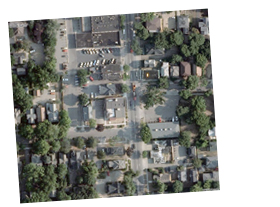 Another student documented live performances, before, during, and after, recording the same place at the same time from different points of view with sound and with still photos. Parallel narratives were shown on three monitors.
Another student documented live performances, before, during, and after, recording the same place at the same time from different points of view with sound and with still photos. Parallel narratives were shown on three monitors.
Another student arrayed data to visualize different places at the same time from the same point of view with a 360 degree panorama. Linked historical information also afforded viewers stories of other times about those places from that point of view.
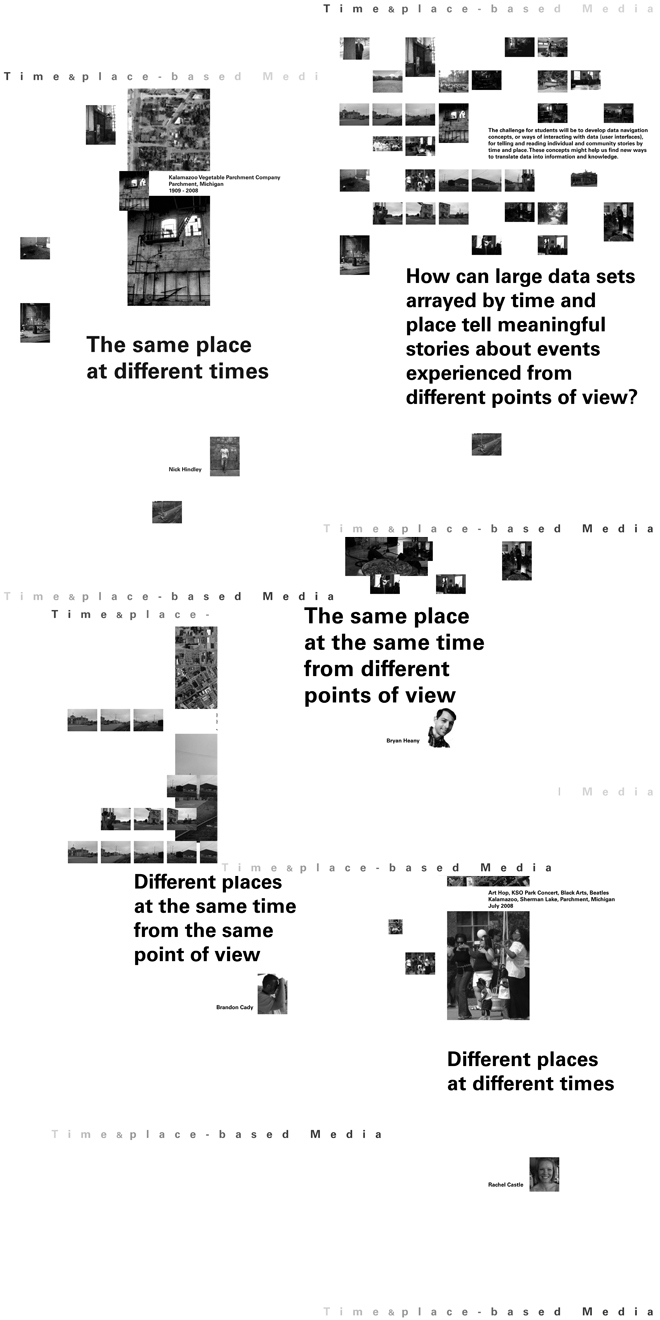
Storytelling is found in every culture, in all of recorded history, in every land. Over the years, storytelling has been a means of communication, education, entertainment, art, and preserving history and culture. Students in this course told stories for many of these same purposes, exploring relationships between time and place.
In the oldest oral traditions, stories became collective works as they were passed from one generation to another over millennia. As technologies advanced, stories in print and other linear media could be accurately replicated as they were passed along. They became individual works affording a version of a story, sometimes with an authoritative cachet. Advancing technologies (now digital media) afford the possibility of collective storytelling once again. This course was an exploration of that possibility!





